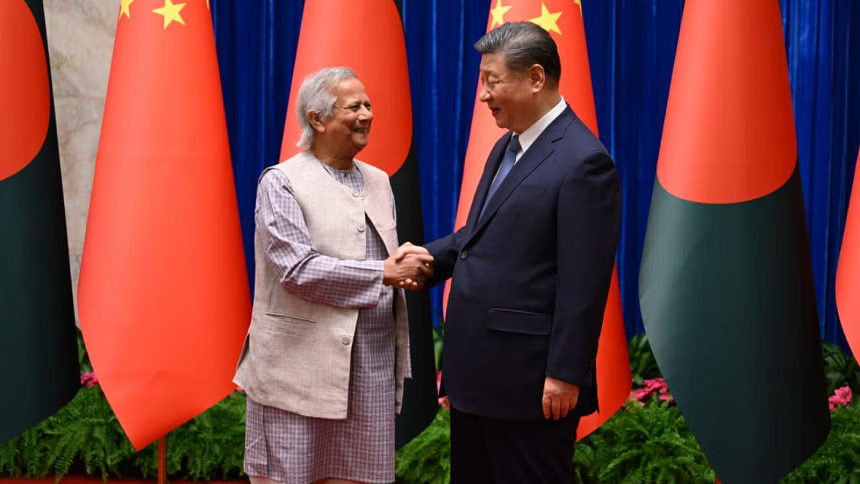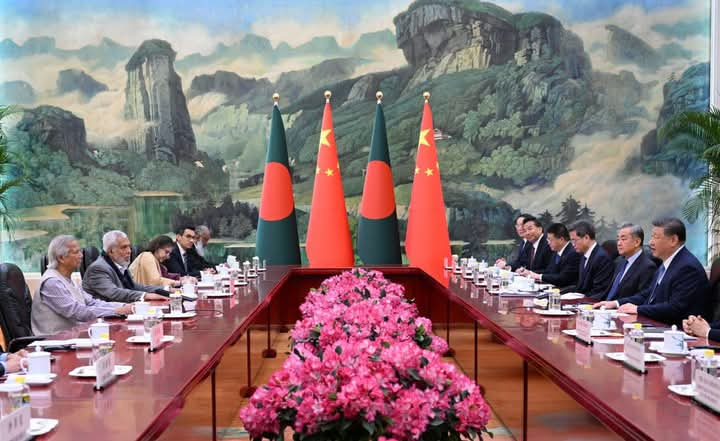Sheikh Hasina’s July 2024 China tour achieved a symbolic upgrade in bilateral ties, secured modest economic aid, and advanced some infrastructure and trade initiatives, but it fell short of her financial goals, reflecting China’s cautious approach at the time. The March 2025 agreements, negotiated by the Jamaat-controlled Yunus-led interim government, represent a continuation and expansion of this relationship, capitalizing on Hasina’s earlier efforts while addressing new national needs after her ouster.
Press Release by Yunus government: Dhaka, Beijing sign nine instruments
Beijing, March 28, 2025: Bangladesh and China on Friday signed one agreement on economic and technical cooperation and eight MoUs on translation and production of classics, exchanges and cooperation on cultural heritage, news exchange, media, sports and health sectors.
In addition to this, five announcements were made on the launching of formal negotiations on investment, the announcement of the commencement of the China Industrial Economic Zone, the signing of a commercial agreement for the modernisation and expansion of Mongla port, the building of a robot physiotherapy and rehabilitation centre, and the donation of a cardiac surgery vehicle.
News Report
Bangladesh has secured a commitment of $2.1 billion in Chinese investments, loans, and grants from the Chinese government and its companies during Yunus’s “milestone” visit to China, according to officials.
Bangladeshi officials and Chinese Ambassador to Dhaka Yao Wen said that nearly 30 Chinese companies have pledged to invest $1 billion in the exclusive Chinese Economic and Industrial Zone (CEIZ) after the chief adviser urged private enterprises to invest in Bangladesh’s manufacturing sector.
China has also agreed to lend $400 million for the Mongla Port modernisation project, $350 million for the development of the CEIZ, and another $150 million as technical assistance. The remaining amount will come as grants and other forms of lending.

“It is a milestone visit,” Chinese envoy Yao Wen said, referring to the chief adviser’s four-day bilateral tour to China.
Others who visited China
Earlier, a 14-member delegation of the Jamaat-e-Islami, Hefazat-e-Islam, Khelafat Majlish and other radical Islamist parties visited China at the end of November.
This follows a recent visit by a delegation from BNP, led by Vice Chairman Asaduzzaman Ripon, who travelled to China at the CPC’s invitation. The four-member BNP team returned to Bangladesh on November 16.
Another 22-member delegation, led by BNP leader Dr Abdul Moyeen Khan, went to China in late February. Apart from five leaders from the BNP and its associated organisations, there were senior leaders from the Ganatantra Mancha, Nationalist Democratic Movement Chairman Bobby Hajjaj, General Secretary of Gono Odhikar Parishad Muhammad Rashed Khan, Joint Secretary General of Bangladesh Khelafat Majlis Maulana Ataullah Amin and Jatiya Dal Chairman Syed Ehsanul Huda.
Dr Moyeen Khan’s wife, Advocate Roksana Khondker, Bangladesh Institute of International and Strategic Studies (BIISS) researcher Md Nahian Sajjad Khan, and Dhaka University’s International Relations department Prof Lailufar Yasmin are also part of the delegation.
Jatiya Nagorik Committee Joint Convener Ali Ahsan Zonaed and Rafe Salman Rifat, both former leaders of Islami Chhatra Shibir’s Dhaka University unit, Co-Spokesperson Md Reaz Hossain, and Coordinator of Students Against Discrimination Mitu Akter are also included, along with two journalists: UNB Special Correspondent Abdur Rahman Jahangir and Diplomatic Correspondent for Dainik Amader Somoy Md Arifuzzaman Mamun.
Analysis of Hasina’s visit
Sheikh Hasina visited China from July 8 to 10, 2024, marking her fifth trip to the country as Prime Minister and her first in five years. This visit came shortly after her reelection in January 2024 and trips to India in June, reflecting her efforts to balance relations with major powers amid Bangladesh’s economic challenges, particularly a foreign exchange crisis.
Hasina sought a $5 billion loan to shore up Bangladesh’s dwindling foreign exchange reserves, aiming to secure funds in Chinese Renminbi to help exporters pay for raw materials imported from China. She aimed to advance Belt and Road Initiative (BRI) projects, including the Teesta River development, and strengthen trade and investment ties. During her visit, China and Bangladesh upgraded their relationship from a “strategic partnership” (established in 2016) to a “comprehensive strategic cooperative partnership.”
This was formalized in a joint statement on July 10, 2024, signaling deeper cooperation across multiple sectors. Twenty-one bilateral agreements were signed. These included three renewed MoUs and new agreements on trade, investment, infrastructure (e.g., the 6th and 9th Bangladesh-China friendship bridges), agricultural exports, digital economy, and people-to-people connectivity.
Specific projects highlighted included the Bangabandhu Sheikh Mujibur Rahman Tunnel, modernization of telecommunication networks, and the Single Point Mooring pipeline. Completion of a joint feasibility study on a China-Bangladesh Free Trade Agreement (FTA) was announced, with formal negotiations set to begin later (a precursor to the 2025 investment talks). 2025 was designated as the “Year of China-Bangladesh Humanities Exchange.”
China supported Bangladesh’s bids for BRICS membership and association with the Shanghai Cooperation Organization (SCO), enhancing Dhaka’s global standing. Progress was noted on major BRI projects like the Padma Bridge Rail Link and Dhaka-Ashulia Elevated Expressway, though no new mega-projects were finalized.
Hasina later stated on July 13, 2024, that despite China’s willingness to participate in the Teesta project, it would be handed to India due to geopolitical considerations.
The $137 million pledged by China was significantly less than the $5 billion sought, prompting Hasina to cut her visit short (returning on July 10 instead of July 11), officially citing her daughter’s health but widely attributed to dissatisfaction with the outcomes.

Leave a Reply